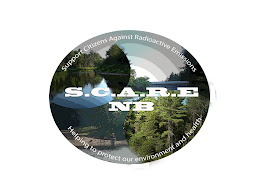1.“Exploration crews searching for uranium will receive radiation exposure from uranium and its associated radioactive decay products in the drill core cuttings” (Radiation Protection Guidelines for Uranium Exploration. Saskatchewan Labour Department, Occupational Health and Safety Division: http://www,labour.gov.sk.ca/safety).
2. “Whether or not [uranium] mining is conducted in open pits or underground, there are environmental health hazards and impacts to workers and the general public that need to be considered. These include radiation hazards from radon gas, radium, thorium, and non-radioactive contamination from dust and heavy metals such as arsenic, lead, and nickel” (Health Canada, Environment and workplace health. Canadian Handbook on Health Impact Assessment. Volume 4, Chapter 5.4 Uranium Mining. http://hc-sc.gc.ca/ewh-semt).
3. Radiation is one of the few exposures for which the cause-effect relationship with childhood leukemia has been established (Belson et al. 2007). Children are 20% more sensitive to radioactivity because their cells are actively dividing.
4. Uranium mining creates risks to workers and the community in several ways: through radioactive dust and radon released from exploring, milling, and tailing piles. (Stephens and Ahern 2001. institute for Environment and Development. World Business Council for Sustainable Development)
5. Uranium enters the body by ingestion or inhaling airborne uranium – contain dust particles or aerosols. Uranium is absorbed from the intestine or lungs, enters the bloodstream, and is rapidly deposited in the tissues, predominately kidney and bone excreted in the urine. (Taylor and Taylor 1997)
6. “Inhalation of radon and radon progeny [daughter products] lead to radiation exposure of the bronchial tissue of the lung with a resultant risk of cancer” (Health Canada: Environmental and Workplace Health. Exposure Guidelines for Residential Indoor Air Quality Section 4.B.2 Radon). Risks of lung cancer in uranium workers, who have been exposed to higher levels of radon, or to longer periods of low exposure, are 2 to 5 times higher than unexposed workers. (Stephens and Ahern 2001. Institute of Environment and Development. World Business Council for Sustainable Development).
7. “The current Canadian guideline for residential radon levels is two to four times weaker than European and Australian guidelines, more than five times weaker than American guidelines, and more than three times weaker than the World Health Organization recommendation” (www.davidsuzuki.org).
8. Residents living near uranium mining operation have a higher risk of genetic damage than people living further away. (Au et al 1998). “radon is the second most significant cause of lung cancer after smoking tobacco, and accounts for approximately 9 to 15 percent of lung cancer deaths” (www.davidsuzuki.org).
9. Miners exposed to uranium are at increased risk of various degrees of genetic damage. . (Stephens and Ahern 2001. Institute of Environment and Development. World Business Council for Sustainable Development).
10. Uranium mining is a federal responsibility, but according to the British Columbia Medical Association to a Royal Commission on Uranium Mining, “the Atomic Energy Control Board is unfit to regulate uranium mining”.
Subscribe to:
Post Comments (Atom)


No comments:
Post a Comment